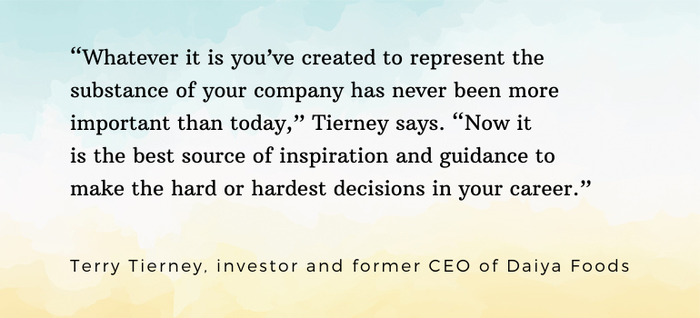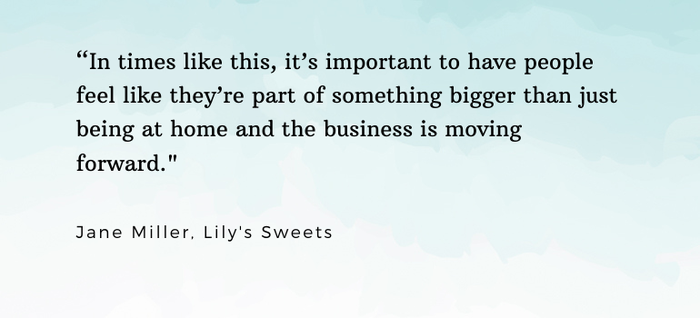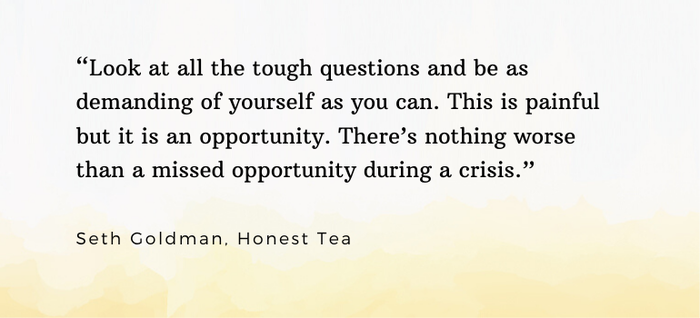Industry veterans offer up words of wisdom for times of crisis
Natural food innovators and entrepreneurs virtually gathered to give their advice for brands navigating a new reality during the COVID-19 pandemic.
March 27, 2020

With the natural food industry grappling on how to manage their businesses in the middle of coronavirus, many industry leaders gathered for a town hall webinar to collaborate on potential solutions.
Co-sponsored by Naturally Network and MBArk, more than 600 people logged into Zoom to attend a virtual meeting held March 25. Topics ranged from how to manage employee safety, morale and payroll to replacing in-store sampling and shifting business models to online sales with direct-to-consumer platforms.
“Never has there been a more throw-the-playbook-out-the-window kind of time,” says Terry Tierney, an investor and former CEO of Daiya Foods.
Citing a need for critical leadership Tierney suggested natural food brands turn to their core values, purpose, mission statements and manifestos as an internal compass to guide them, even if they were originally created as a fun exercise.
“Whatever it is you’ve created to represent the substance of your company has never been more important than today,” Tierney says. “Now it is the best source of inspiration and guidance to make the hard or hardest decisions in your career.”
Effectively communicate
Multiple industry leaders expressed the need to communicate frequently and clearly with their team members, vendors, customers and consumers as they navigated potential threats and opportunities in the new business environment.
Have multiple people read any communication before it’s digitally posted, Tierney says.
Gary Hirshberg, co-founder and chief organic optimist of Stonyfield Farm, says overcommunication was essential to his success, especially during his toughest financial hardships, when payroll was unreliable and banks wouldn’t talk to him as he was trying to launch his brand.
To keep everyone informed, Hirshberg held daily meetings with his entire staff, somethings only lasting 10 minutes, to walk employees through what would happen that day. He also recommends constantly and chronically calling vendors as well as shareholders, equity holders or debt holders to keep everyone informed.
“People need to hear from you,” says Hirshberg, who founded the Hirshberg Entrepreneurship Institute, which will soon begin hosting online webinars for business leaders. “And you can’t do it too much.”
For Nick Green, CEO of Thrive Market, that’s meant being transparent and communicating with its more than 1.4 million members—including its 700,000 paid members—to be “crystal clear” about where they stand on inventory and shipping times so they underpromise and overdeliver.
Touchpoints can be short and humorous, but people need to see and hear from their leaders too, Hirshberg says, especially for those who are on the front lines working in the plants.

Jane Miller, CEO of Lily’s Sweets, says she’s sending daily updates to her team of 45 people to give everyone a sense that the business is still moving forward, selling products on e-commerce and getting wins with customers. She’s also doing weekly video calls and a virtual happy hour where employees share personal anecdotes about their home and personal life during the coronavirus period.
Last week, Miller sent out a personal note to everyone via snail mail. “Of all the things we’ve done so far, I feel like that’s had the greatest impact on my team, to get a personal note,” Miller says.
Miller also created a “$50 Amazon Challenge” to engage her employees to get creative about what they could do around their house with their family. Employees bought everything from leashes for their dogs and puzzles to Legos and artist supplies. She’s also using the “My Talking Pet” app to have her dog, Bella, send out a note to her team.
“In times like this, it’s important to have people feel like they’re part of something bigger than just being at home and the business is moving forward,” Miller says.
Preserve capital and watch your efficiency
“Watch your cash as never before,” Hirshberg says. If you have a line of credit, draw it down to gain financial flexibility.
Consider working your distributors to accelerate payments to help with cash flow issues with the surge or to get extended terms, he says.
“In challenging times, it’s always important to ask for help,” says Paddy Spence, the founder of SPINS and CEO of Zevia. “It’s surprising how flexible even large partners can be.”
Set up a plan where you can live with the downside, suggests Mo Siegel, one of the founders of Celestial Seasonings. And if you can’t live with the downside, don’t do it.
Since this is a bad time to be looking for private equity, keep your cash and inventories tight and avoid bringing on anyone new or having a fire sale, Siegel says.
Make sure your supply chain is intact as possible, says Denis Ring, founder of OCHO Candy. He thinks it will take at least several months for suppliers to “get their hands around” the production schedule that will be needed to flatten the curve to get caught up with consumer demand over panic buying.
Be in constant contact with each of your large retail partners and be prepared to see wild swings going up and down of what non-necessities are filling up trucks going to stores, he says.
“We’re building up our inventory,” Ring says. “But we also don’t want to use up inventory to burn down our cash supply.”
Protect your health, create new protocols
With COVID-19 circulating, be selfless and get the sleep you need, Hirshberg says, to protect against the virus while keeping your energy and “juice for your team,” while making time to exercise.
In the early days of Stonyfield, Hirshberg says after working an 18-hour day, he’d play tennis at 10 p.m. with another struggling entrepreneur because they could get free court time.
“I knew if I went home I would be a terrible husband, terrible mate, terrible spouse, I just needed to get the juice out,” Hirshberg says. “I’d often be whacking tennis balls with tears flowing out of my eyes just to get that tension off for the day, but it is really critical.”

For front-line employees, Green recommends doing temperature checks at the start of each shift with mandatory wipe downs of all surfaces at the start and end of shifts. Everyone is getting gloves and he’s encouraging people to stay home not only if they are sick but if anyone in their household is.
If a worker at the production facility is diagnosed with COVID-19, Blair Kellison, CEO of Traditional Medicinals, says their plan is to shut down for 72 hours—the amount of time the virus can live on stainless steel. Kellison says they’ll then call the Department of Health, have a crew come in and sterilize the plant.
“It’s an evolving plan,” Kellison says. “It depends on where the employee worked and how much interaction they had with other people. There’s a lot of scenario planning.”
Support your team
Companies are only as good as the team, Spence says.
People want to know you’re going to take care of them, that as a leader you’re going to work as hard or harder than anyone on the team to understand and create to the COVID-19 crisis, he says.
“I’ve seen amazing products that didn't achieve success because of a weak team,” Spence says. “And I've seen some pretty mediocre products do phenomenally well because they had an incredible team of passionate people around them.”
To build that kind of trust and commitment to a brand, company owners need to show their commitment to employees. For example, Facebook gave each employee $1,000 bonuses, but more importantly, told everyone their six-month review would say the same thing: “exceeds expectations.”
While everyone is worrying about health and safety, the last thing employees should be worrying about is how they are doing versus a peer, Spence says.
To take care of his team, Spence says they implemented a fair wage policy a year and a half ago where the minimum annual compensation for full-time employees was $50,000, just over $24 an hour.
That’s coupled with a CEO salary metric where Spence’s salary to the lowest-paid employee is 6.1 times to support the lower paid folks faster than his pay increases, which has helped to motivate and retain valuable team members.
Evolve into the new more-virtual environment
With brands no longer being able to fly across North American to see retailers, it’s a good time to start using technology and go paperless.
“We’re reinventing the way we do things,” says Spence, who has switched his company to video conferencing. “The old way is no longer the way.”
As retailers try to stock shelves to keep up with consumer demand, forget any planned resets, promotions and activities for the rest of the year with an “all hands on deck” approach to get products on the shelves, Ring says.
Green says many consumers did massive panic buying starting on March 11 and are now in a “hunkering down” mode preparing food for themselves at home. This will likely affect consumer consumption for the rest of the year, Green says, even as shelter-at-home orders are lifted but people continue to follow an extended period of social distancing.
“This is a problem that is not going to go away for many, many months,” says Green, pointing to the Thrive Market COVID-19 Relief Fund that was created to give $150 food gift cards to families impacted by coronavirus.

Pair back offerings
Distributors can’t keep up with throughput. Buyers don’t want to hear from you right now … look at this as an opportunity and refine what you hope to offer, says Seth Goldman, co-founder of Honest Tea.
Many on the call suggested building volume in leading SKUs by temporally pairing back less popular items and reducing flavor assortments and sizing, to get more efficiency, better gross margins and to help line workers with less changes. By reducing variability, it can increase throughput.
“It’s about converting inventory into cash,” Hirshberg says.
Track important metrics
Create a dashboard of your most important KPIs, says Mo Siegel. If you’re running a manufacturing plant take and track the temperature of everyone who is walking through the door.
Track your consumers to better understand their feelings and shifting behaviors, says Mark Retzloff, co-founder and chairman of Alfalfa’s Markets.
“That’s going to be important as the world comes back,” Retzloff says. “We’re not going to go back to something that’s normal. It’s going to be different. So when this crisis settles back down you can leverage the opportunities out there.”
Collaborate with other brands, influencers
Small startups should consider collaborating on supply chain or marketing. Look at complementary categories or even within your own category to collaborate on consumer education or host a creative sampling program, says Carlotta Mast, senior VP of Content and Insights at New Hope Network.
“Now is the perfect time, particularly for early stage brands to find others you can work with,” Mast says. “By pooling your resources you might be able to do more.”
Mast also suggests looking at Parsnip, a San Francisco-based startup whose platform helps early stage brands do creative collaboration.
Get creative, find opportunities
Even with in-store sampling going away, many consumers want to eat well and in a healthier manner, Hirshberg says. That means a lot of consumers are willing to try new products, which creates an opportunity especially for brands that can sell directly to consumers from their websites.
Use this time to sharpen your business. To get in-person sampling, Tierney says, consider putting your product in the hands of first responders, Tierney says.
To refine what you hope to offer in the future, get some feedback from foodservice managers who might be sitting around looking for an opportunity, Goldman suggests.
“Look at all the tough questions and be as demanding of yourself as you can,” Goldman says. “Because this is painful but it is an opportunity. There’s nothing worse than a missed opportunity during a crisis.”
About the Author
You May Also Like




